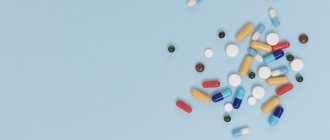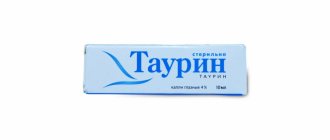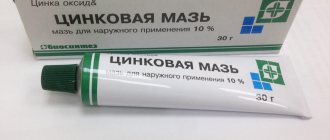Sulfonamide drugs (sulfonamides) are a large group of synthetic drugs - derivatives of sulfanilic acid amide that have an antibacterial effect.
Sulfonamides are the very first of all groups of synthetic drugs that were used to treat bacterial infections.
Sulfonamides have a narrow spectrum of action, that is, they affect a small number of pathogens of bacterial infectious diseases, and are also quite toxic. With the availability of more effective and safer antibacterial drugs (broad-spectrum antibiotics, fluoroquinolones), this significantly limits the use of sulfonamides in modern clinical practice.
Chemical properties
antibiotic of a number of sulfonamides, it is also called streptocide . It is one of the first representatives of this series of antibacterial agents. Has a wide spectrum of antimicrobial activity.
The medicine is synthesized in the form of a white crystalline powder, without a specific odor, bitter taste, the aftertaste of the powder is sweet. The substance dissolves well in boiling water, difficultly - in ethyl alcohol, soluble - in hydrochloric solution , caustic alkali , glycerin , acetone , propylene glycol . The product is insoluble in chloroform , ether , benzene , petroleum ether . The molecular weight of the compound is 172.2 grams per mole.
The antibiotic is also sold as sodium sulfonamide . It is a white powder, highly soluble in water. Practically insoluble in various organic solvents. Also available in tablet form.
Sulfanilamide preparations are mainly used externally, in the form of ointments, powders for external use, liniment, aerosols, and as part of vaginal suppositories. However, the medicine can also be taken orally.
Price for sulfonamide drugs
It is not a problem to buy medications in this group in an online store or at a pharmacy. The difference in cost will be noticeable if you order several drugs from a catalog on the Internet at once. If you buy the medicine in a single version, you will have to pay extra for delivery. Domestic-produced sulfonamides are inexpensive, while imported drugs are much more expensive. Approximate price for sulfonamide drugs:
| Name | Manufacturer | Price in rubles |
| Sulfanilamide (White streptocide) 250 g | Switzerland | 1900 |
| Biseptol 20 pcs. 120 mg each | Poland | 30 |
| Sinersul 100 ml | Republic of Croatia | 300 |
| Sumetrolim 20 pcs. 400 mg each | Hungary | 115 |
Pharmacodynamics and pharmacokinetics
Mechanism of action of the substance
The drug acts as an antagonist of para-aminobenzoic acid due to its chemical similarity to it. dihydropteroate synthetase is inhibited by a competitive mechanism. The processes of synthesis of dihydrofolic acid and tetrahydrofolic acid , which, in turn, are necessary for the formation of pyrimidines and purines , the growth and development of harmful microorganisms. Thus, the substance produces a bacteriostatic effect.
Antibiotics Sulfonamides are active against gram-positive and gram-negative cocci, streptococci, meningococci, pneumococci, gonococci, Vibrio cholerae, Bacillus anthracis, Yersinia pestis, Actinomyces israelii, Shigella spp., Clostridium perfringens, Corynebacterium diphtheriae, Chlamydia spp., Toxoplasma gond ii, Shigella spp. When used topically, it significantly accelerates wound healing.
After the substance enters the digestive tract, the maximum concentration of the drug in the blood is observed after 1-2 hours. The half-life is less than 8 hours. The product overcomes all histohematic barriers , including the BBB and the placental barrier. 4 hours after administration, the substance can be detected in the cerebrospinal fluid. Metabolized in the liver, metabolites do not have antibacterial properties. The antibiotic is excreted mainly through the kidneys (up to 95%).
The medicine has not been studied for mutagenic and carcinogenic effects on the body.
Indications for use of Sulfanilamide
The antibiotic is used locally:
- for the treatment of tonsillitis ;
- for ulcers , cracks and infected wounds of various origins;
- in patients with purulent-inflammatory skin lesions;
- for boils , carbuncles , pyoderma ;
- patients with folliculitis , with erysipelas, with acne ;
- with impetigo ;
- for the treatment of first and second degree burns.
At the moment, the drug is practically not used for oral administration. Previously, it was used in the treatment of tonsillitis , erysipelas , pyelitis , cystitis , enterocolitis , for the prevention and treatment of wound infections. Sulfanilamide was also administered in dissolved form (5% solution in water) intravenously, ex tempore.
List of sulfa drugs
According to the period of circulation, sulfonamides antibiotics are divided into: short, medium, long and extra long exposure. It is impossible to list all drugs, so this table shows long-acting sulfonamides used to treat many bacteria:
| Name | Compound | Indications |
| Arghedine | silver sulfadiazine | infected burns and superficial wounds |
| Argosulfan | silver sulfadiazine | burns of any etiology, minor injuries, trophic ulcers |
| Norsulfazole | norsulfazole | pathologies caused by cocci, including gonorrhea, pneumonia, dysentery |
| Oriprim | sulfamethoxazole | infections of the urinary canal, respiratory tract, soft tissues, skin |
| Pyrimethamine | pyrimethamine | toxoplasmosis, malaria, primary polycythemia |
| Prontosil (Red streptocide) | sulfonamide | streptococcal pneumonia, puerperal sepsis, erysipelas of the skin |
Contraindications
Drugs based on this antibiotic are not prescribed:
- if allergic to the substance or other sulfonamides ;
- for anemia , diseases of the hematopoietic system;
- patients with liver and kidney failure;
- for porphyria , azotemia ;
- patients with congenital deficiency of glucose-6-phosphate dehydrogenase ;
- with thyrotoxicosis .
Patients should be especially careful during breastfeeding and pregnancy.
What are sulfa drugs
Sulfanilamide (sulfonamides) include synthetic antimicrobial drugs that are derivatives of sulfanilic acid (aminobenzenesulfamide). Sodium sulfanilamide suppresses the vital activity of cocci and bacilli, affects nocardia, malaria, plasmodia, proteus, chlamydia, toxoplasma, and has a bacteriostatic effect. Sulfonamide drugs are medications prescribed to treat diseases caused by pathogens that are resistant to antibiotics.
Side effects
When used topically, Sulfanilamide most often does not cause any adverse reactions. Allergic rashes may occur .
When taken orally or topically in large quantities, the following are observed:
- headaches , paresthesia ;
- dizziness , nausea, tachycardia ;
- indigestion , dyspepsia , agranulocytosis ;
- cyanosis , crystalluria .
Rarely may occur:
- thrombocytopenia , hypoprothrombinemia , leukopenia ;
- decreased visual acuity, ataxia , hypothyroidism .
Features of treatment with sulfonamides
Sulfonamide drugs can provoke severe allergic reactions, abdominal pain, diarrhea, as well as hematopoietic disorders - anemia, leukopenia, thrombocytopenia.
The metabolic products of sulfonamides are poorly soluble, especially in the acidic environment of urine - they easily precipitate in the form of crystals (crystalluria), which can lead to blockage of the kidney tubules. To prevent the development of this effect when taking sulfonamides, you should drink plenty of fluids (preferably alkaline - a weak solution of baking soda, alkaline mineral waters).
With long-term use of sulfonamide drugs, a general blood and urine test should be performed regularly (at least 1-2 times a month).
If the slightest sign of a rash appears on the skin or mucous membranes, as well as any other signs of side effects when using sulfonamide drugs, taking these drugs should be stopped immediately.
Instructions for use of Sulfanilamide (Method and dosage)
The medicine is used topically, taking into account the recommendations described in the instructions for a particular dosage form.
10% and 5% ointment, liniment or powder are applied to the affected surfaces or to a gauze bandage. Dressings are done once a day.
When treating deep wounds, the product is introduced into the wound cavity in the form of crushed (to dust) sterilized powder. Dosage from 5 to 15 grams. In parallel, systemic treatment is carried out and antibiotics for oral administration.
The drug is also often combined with ephedrine , sulfathiazole and benzylpenicillin to treat rhinitis . It is used in powder form. The powder (carefully crushed) is inhaled through the nose.
Sulfanilamide can be used orally in a daily dosage of 0.5 to 1 gram, distributed over 5-6 doses. For children, it is recommended to adjust the daily dosage depending on age. The maximum amount of antibiotic that can be taken per day is 7 grams, 2 grams at a time.
Classification of sulfonamide drugs
In terms of their activity, sulfonamide drugs are inferior to antibiotics (not to be confused with sulfonanilides). These drugs have high toxicity, so they have a limited range of indications. The classification of sulfonamide drugs is divided into 4 groups, depending on pharmacokinetics and properties:
- Sulfonamides are rapidly absorbed from the gastrointestinal tract. They are prescribed for systemic treatment of infections that are caused by sensitive microorganisms: Etazol, Sulfadimethoxine, Sulfamethizole, Sulfadimidine (Sulfadimezin), Sulfcarbamide.
- Sulfonamides, incompletely or slowly absorbed. They create a high concentration in the large and small intestines: Sulgin, Ftalazol, Ftazin. Etazol sodium
- Topical sulfonamides. Well proven in eye therapy: Sulfacyl sodium (Albucid, Sulfacetamide), Silver sulfadiazine (Dermazin), Mafenide acetate ointment 10%, Streptocide ointment 10%.
- Salazosulfonamides. This classification of sulfonamide compounds with salicylic acid: Sulfasalazine, Salazomethoxine.
Drugs containing (Analogs)
Level 4 ATC code matches:
Dermazin
Streptocide
Argosulfan
Ebermin
List of Sulfonamides drugs: Streptocide-LekT , powder for external use Streptocide , Streptocide white soluble, Streptocide tablets, Streptocide ointment 10%.
Names of drugs containing C treptocide in combination with other substances: suppositories Osartsid , Ingalipt-VIAL , Ingalipt aerosol, Novoingalipt spray, Co-Trimoxazole (combination with trimethoprim), etc.
Combined sulfonamide drug
Time does not stand still, and many strains of microbes have mutated and adapted. Doctors have found a new way to fight bacteria - they have created a combined sulfonamide drug, which combines antibiotics with trimethoprim. List of such sulfopreparations:
| Titles | Compound | Indications |
| Bactrim | sulfamethoxazole, trimethoprim | gastrointestinal infections, uncomplicated gonorrhea and other infectious pathologies. |
| Berlocid | sulfamethoxazole, trimethoprim | chronic or acute bronchitis, lung abscess, cystitis, bacterial diarrhea and others |
| Duo-Septol | sulfamethoxazole, trimethoprim | antibacterial, antiprotozoal, broad-spectrum bactericidal agent |
| Tsiplin | sulfamethoxazole, trimethoprim | typhoid fever, acute brucellosis, brain abscess, inguinal granuloma, prostatitis and others |
Reviews
Reviews write mainly about the use of Streptocide topically, for weeping wounds, for healing acne , herpes , stomatitis , for sore throat and sore throat. Patients note the high effectiveness of the product, minimal side effects, and low cost. Some are not satisfied with the “powder” release form; patients prefer ointments or tablets.
- “...Streptocide is always in our family medicine cabinet; my mother, my grandmother, and I use it. An excellent tool, inexpensive, always at hand, time-tested”;
- “...I have been using this product for a very long time. After removing the wart I used it, the wound healed quickly and did not get wet at all. Now used to treat wounds from contact dermatitis, it heals quickly”;
- “... As soon as my throat hurts, I start dissolving Streptocide tablets. Three or four times a day, then I don’t drink anything for half an hour, probably. Helps immediately. After 2 days nothing hurts anymore.”
Doctors have recently stopped using Sulfanilamide for oral administration. Most often, its analogues from the same group are prescribed or the medicine is combined with other antibacterial agents. Despite the fact that the drug has a wide spectrum of activity and a persistent bactericidal effect, there are drugs that are better tolerated and to which harmful microorganisms do not develop tolerance.
Sulfonamide drugs for children
Since these drugs are broad-spectrum drugs, they are also used in pediatrics. Sulfonamide preparations for children are produced in tablets, granules, ointments and solutions for injections. List of medications:
| Name | Compound | Application |
| Septrin | sulfamethoxazole, trimethoprim | from 6 years: gastroenteritis, pneumonia, wound infections, acne |
| Etazola tablets | sulfaethidol | from 1 year: pneumonia, bronchitis, sore throat, peritonitis, erysipelas |
| Sulfargin | silver sulfadiazine | from 1 year: non-healing wounds, bedsores, burns, ulcers |
| Trimezol | co-trimoxazole | from 6 years: infections of the respiratory tract, genitourinary system, skin pathologies |
- Bergamot - what kind of plant is it? Useful properties and uses of bergamot essential oil
- How to get rid of snakes in your summer cottage
- Enterobiasis in adults - symptoms and treatment with drugs










